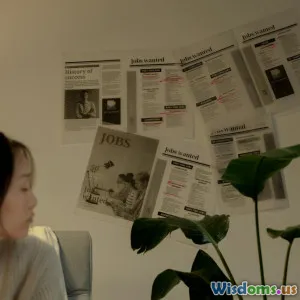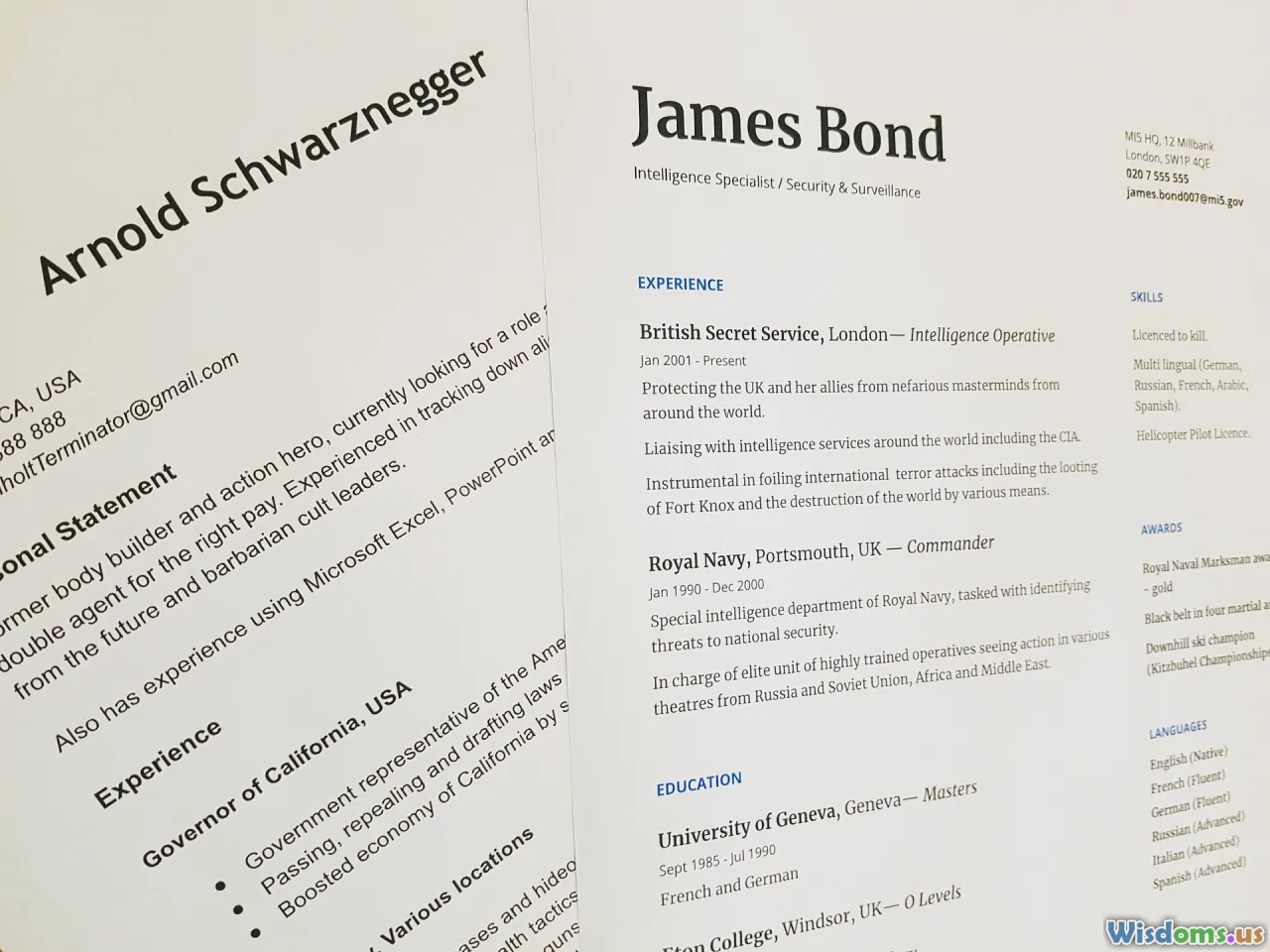
How to Turn Career Setbacks Into New Opportunities for Growth
32 min read Practical strategies to reframe layoffs, failures, and plateaus into catalysts for skill-building, networking, and career pivots. Assess, upskill, experiment, and negotiate smarter for resilient growth. (0 Reviews)
You don’t plan for a layoff, a missed promotion, or a failed project. They arrive with the clatter of uncertainty, all sharp edges and second-guessing. Yet buried in the rubble is a lever you can pull. Setbacks can become raw material for reinvention—if you handle them deliberately. What follows is a practical playbook to help you turn career turbulence into momentum, with concrete steps, real-world examples, and tools you can act on today.
See the Setback Clearly: What Really Happened?

When you’re rattled, your brain scans for threat rather than facts. Before you rush to next steps, get clear on what happened and why. There are patterns in setbacks, and understanding the pattern points you to the right intervention.
Common categories of career setbacks:
- Macro shock: Layoffs, hiring freezes, or budget cuts. These often reflect company or sector trends rather than personal performance.
- Role mismatch: Strengths and responsibilities don’t align; the job’s success metrics aren’t how you naturally create value.
- Skills gap: Competency shortfalls become apparent under new standards (e.g., a shift to cloud-native tools or value-based care in healthcare).
- Political misfire: Misaligned stakeholders or inadequate influence map; you delivered but didn’t carry the room.
- Personal constraint: Health, caregiving, burnout, or bandwidth issues that capped performance.
How to analyze it:
- Gather three views: your own, a trusted peer’s, and a manager’s (former or current). Ask: “What did you see me do well? What caused the outcome? What would you change if you were me?”
- Separate causes into systemic (outside your control) and behavioral (inside your control). Label each factor on a 0–10 control scale. You’ll act on the 6–10s first.
- Create a one-page timeline of the 3–5 decisions that mattered most. This helps you see leverage points rather than drowning in details.
Example: Sam missed a promotion. His analysis showed he over-indexed on “doing the work” and under-indexed on “narrating the work” to decision-makers. That points to a storytelling and stakeholder strategy shift—not simply “work harder.”
Reset Your Headspace Without Losing Your Edge

Motivation is fuel. When you’re discouraged, the fuel tank leaks. Patch it first.
Psychology-backed resets:
- Name it to tame it: Label the emotion—anger, shame, anxiety. Affect labeling reduces amygdala activation and helps restore executive function.
- Growth mindset in practice: Swap “I’m not good at this” for “I’m not good at this yet; here’s the plan to improve.” The word “yet” keeps the door open.
- Cognitive reframe: Replace global attributions (“I failed”) with specific, time-bound ones (“In Q2, I missed X because I did Y; I’m changing Z”).
- Pen-and-paper purge: 10 minutes of expressive writing for three days has been shown in multiple studies to improve mental clarity and even job performance metrics over time.
Daily reset routine (30 minutes):
- 5 minutes: Breathwork or a brisk walk to discharge stress.
- 10 minutes: Journal—three bullet points on what happened, what you control, and one small win from the last 24 hours.
- 10 minutes: Skill micro-practice (e.g., an interview question, SQL query, or clinical protocol review).
- 5 minutes: Outreach to one person you respect. Connection is the antidote to rumination.
If the emotional load feels heavy for more than two weeks, consider a counselor. Your brain is your career engine; maintenance isn’t optional.
Stabilize Your Runway: Money, Benefits, and Time

A short financial runway amplifies fear. A longer runway multiplies options.
- Calculate runway: Savings ÷ monthly essential spend = months of runway. Add commitments (severance, unemployment benefits, freelance income) conservatively.
- Trim burn rate quickly: Cancel unused subscriptions, negotiate bills (many providers will reduce rates), pause nonessential spending. Even a 15% reduction can add weeks of runway.
- Benefits checklist:
- Severance: Clarify payout schedule, continuation of benefits, and non-compete/non-disparagement clauses.
- Health coverage: Compare employer continuation options with marketplace alternatives.
- Retirement: If you had a company match or equity, understand vesting dates and rollover timelines.
- Unemployment insurance: Eligibility and amounts vary by region; apply promptly to avoid gaps.
- Time block: Create a weekly schedule with half-days reserved for job search and half-days for skill-building or consulting. Context switching kills productivity; batch tasks.
Example: Priya, a marketing manager, shaved $600/month by renegotiating internet and insurance, pausing a gym membership, and moving to a family phone plan. That extended her runway by nearly three months—time she used to complete a digital analytics certification and land a higher-paying role.
Run an After-Action Review to Extract the Gold

The After-Action Review (AAR), popularized by the U.S. Army, has four questions:
- What did we set out to do?
- What actually happened?
- Why did it happen?
- What will we sustain and change next time?
How to apply it to a missed promotion or failed project:
- Collect artifacts: Emails, briefs, dashboards, feedback notes. Evidence beats memory.
- Build a blame-free timeline: Focus on decisions and signals, not villains.
- Identify leading indicators you missed. For example, if your initiative faltered due to late stakeholder alignment, the leading indicator might be “percent of decision-makers signed onto the problem definition by week 2.”
- Convert insights into habits. Example: “Start every major project with a one-page alignment memo and a pre-mortem.”
Example AAR for a product launch delay:
- Goal: Launch by May 1 with 95% SLA.
- Reality: Launched May 29 with 88% SLA.
- Why: Integration risks under-scoped; QA capacity overestimated; legal review late.
- Sustain: Weekly cross-functional sync worked well.
- Change: Add a risk burndown chart, fast-track contract review, and a QA capacity guardrail.
This isn’t academic. You’ll reuse these insights in interviews to demonstrate maturity and learning agility.
Build an Evidence-Based Career Hypothesis

A setback invites a reset. Before you sprint, choose a direction.
- Values scan: Rank your top 5 work values—autonomy, impact, learning, stability, collaboration, compensation. Misalignment here causes chronic friction.
- Skills inventory: List 10–15 skills you use, then tag them: energizing vs. draining, strong vs. weak. The aim is to spend more time in energizing + strong or energizing + buildable.
- Transferable skills: Map accomplishments to verbs, not titles: led, analyzed, negotiated, designed, treated, trained. This reframes your trajectory for new sectors.
- Market scan: Review 50 recent job postings in roles that interest you; tally skills and tools that recur. Start with regions and industries you can reach in one or two steps.
- Hypothesis statement: “I create disproportionate value when I [verb] for [customer] by [method] in [context]. Therefore, I’m targeting [roles/industries].”
Example: “I create value when I translate data into clear decisions for non-technical leaders by building lightweight models and narratives in fast-moving environments. Therefore, I’m targeting analytics roles in mid-market healthcare or logistics firms.”
A sharp hypothesis filters noise, improves your pitch, and makes networking concrete.
Pivot, Persevere, or Reset? Choosing Your Path

Not all setbacks require a pivot. Use this decision lens.
- Persevere: Stay on the same path but adjust tactics.
- When: You still love the work, the market is stable, and your AAR shows tactical gaps you can fix in 90 days.
- Example: Missed promotion due to visibility. Plan: biweekly stakeholder updates, present in cross-team forums.
- Pivot: Same skills, new context or adjacent role.
- When: Your sector shrank but your skills are portable. Example: Event manager pivots to field marketing or customer success.
- Risk/Reward: Medium risk, fast learning curve, quicker job market signal.
- Reset: New skills, new path.
- When: Chronic misfit or sector decline. Example: On-prem systems admin transitions to cloud engineering.
- Risk/Reward: Higher upfront effort; potentially greater long-term upside.
Decision matrix cues:
- Energy: Does imagining the next year in this path energize you? If not, pivot/reset signals increase.
- Market: Is demand rising, flat, or falling? Rising markets forgive mistakes.
- Leverage: Do you have 2–3 unfair advantages (network, certifications, portfolio) you can deploy quickly?
High-ROI Skill Sprints That Employers Notice

Skill-building pays off when it is visible, verifiable, and valuable.
- Define a sprint: 6–8 weeks focused on one skill cluster tied to your hypothesis (e.g., SQL + Looker for analytics; Figma + design systems for product design; modern wound care protocols for nursing).
- Build while learning: Cap each week with a small artifact: a dashboard, a case study, a protocol summary, a demo app. Artifacts become portfolio pieces.
- Choose signals that transfer:
- Certifications: Project management, cloud fundamentals, analytics, or safety/quality credentials in healthcare. Entry-level certs can be completed in weeks and signal commitment.
- Micro-credentials: Short, employer-recognized programs are effective if paired with real projects.
- Open-source or community contribution: Pull requests, documentation, or case reports.
- Socialize your progress: Weekly posts summarizing what you learned and built. Hiring managers notice consistent builders.
Example plan (data analyst pivot):
- Week 1–2: SQL basics → publish 2 practice analyses on public datasets.
- Week 3–4: Visualization (Power BI/Tableau) → replicate a business dashboard and explain decisions.
- Week 5: Business acumen → write a one-pager translating data into actions for a pretend VP.
- Week 6: Capstone → analyze a dataset from your target industry with clear recommendations.
Outcome to track: Can you show three artifacts, one credential, and one testimonial within 8 weeks? That bundle moves interviews.
Upgrade Your Resume, LinkedIn, and Portfolio

Your career assets should make it obvious you can solve the employer’s problem.
Resume rules that survive ATS and impress humans:
- One-liner value prop at the top: “Operations leader reducing cycle times 20–40% in supply chains under $200M.”
- Metric-first bullets using the problem–action–result pattern.
- Keywords: Mirror the language in target postings (tools, methods, frameworks) without keyword stuffing.
- Cut fluff: Replace “responsible for” with vivid verbs and numbers.
Bullet transformation example:
- Weak: “Managed social media accounts.”
- Strong: “Grew qualified leads 38% in 6 months by launching a content calendar, A/B testing creatives, and reallocating 25% of spend to high-ROI channels.”
LinkedIn upgrades that drive discovery:
- Headline formula: Role you do + outcome + niche. Example: “Clinical Project Manager | Accelerating trial start-up by 20% | Oncology & Rare Disease.”
- About section: 3 short paragraphs—what you do, proof (3 bullets with metrics), what you want next.
- Featured: Pin 3–5 artifacts (case study, deck, GitHub, publication, poster).
- SEO: Add target skills in Skills & Endorsements and throughout experience bullets.
- Open to Work: Use it strategically; if you prefer subtlety, limit visibility to recruiters.
Portfolio crafting:
- Problem-solution narratives: Each project should state the problem, constraints, your approach, and measurable outcomes.
- Show work: Screenshots, code snippets, before/after metrics, process diagrams.
- One page per project beats one page with 10 thumbnails. Depth trumps breadth.
Network Like a Human: Earned Introductions and Small Asks

Networking is value exchange, not a transaction. A good strategy is simple and kind.
- Start with warm circles: Former colleagues, classmates, clients, vendors. Ask for perspective, not a job.
- Two-lane outreach: Alternate between offering help (share an article, make a relevant intro) and asking for a quick call.
- Small asks: “Could we do a 15-minute call to learn how your team approaches customer onboarding?” is easier to accept than “Do you have a job for me?”
Message template:
- Subject: Quick learning chat about [specific topic]
- Body: “Hi [Name], I admire how [company/team] [specific observation]. I’m exploring roles in [area] and would value your perspective for 15 minutes on [two focus questions]. If not you, is there someone you recommend? I’ll share a brief summary afterward. Thanks either way.”
Make it compounding:
- After a chat, send a one-paragraph summary of what you learned and how you’ll apply it. People remember those who respect their time.
- Ask, “Who else should I learn from?” End each conversation with one introduction request.
- Track: Keep a simple CRM (spreadsheet) with columns for date, topic, notes, next step.
Example: Luis, a clinical lab technologist, used 25 informational interviews to pivot into quality assurance at a diagnostics startup. His ask was always for process insights; two referrals led to interviews.
Nail Your Story: Turning a Setback Into a Strength

Interviewers listen for self-awareness, accountability, and learning. Script your story.
Three-sentence exit story framework:
- Neutral reason: “After a reorganization, my role was eliminated along with 12% of the team.”
- Ownership learning: “It surfaced how much I enjoy stakeholder mapping and led me to strengthen that muscle through [action].”
- Forward link: “I’m targeting roles where I can [value] for [customer], which is why I’m excited about this team.”
If performance played a role, keep it honest and constructive:
- “I missed a key milestone due to underestimating integration complexity. I implemented a risk review and weekly cross-team planning, which helped me deliver the next two launches early.”
STAR+L (Situation–Task–Action–Result + Learning) for failure stories:
- Situation: “I led a pilot for a new patient intake tool.”
- Task: “Reduce average intake time by 20%.”
- Action: “I focused on UI fixes but underestimated coordination with compliance.”
- Result: “We hit only 8% improvement.”
- Learning: “I created a regulatory checklist and embedded compliance in weekly sprints; the next pilot hit 22%.”
Practice out loud. The first draft reads fine, the second draft sounds human, the third draft lands.
A Targeted Search Strategy That Doesn’t Burn You Out

Random applications rarely produce results. Treat your search as a pipeline.
- Weekly targets: 3 tailored applications, 5 warm conversations, 1 artifact published. Quality beats volume.
- Kanban your search: Columns for “Target,” “Applied,” “Interview,” “Offer.” Limit work in progress.
- 80/20 tailoring: Customize the top third of your resume, the first four bullets, and the cover letter.
- Prep sprints: For each interview loop, research the business model, write a 30–60–90-day plan draft, and prepare 5 thoughtful questions.
Metrics to track:
- Application-to-interview rate: Under 10%? Your targeting or resume-market match needs work.
- Interview-to-offer rate: Under 20%? Improve storytelling, technical practice, or business case.
- Time allocation: At least 30% on networking, 30% on skill-building/portfolio, 40% on targeted applications.
Alternative Opportunity Paths: Create Your Own Momentum

Bridges beat gaps. Short-term, real work keeps skills sharp and creates stories.
- Freelance/consulting: Package a clear offer—“Set up your analytics dashboard in two weeks”—priced as a project. Use your network first; platforms are secondary.
- Contracting/temporary roles: Especially effective in healthcare, IT, and operations. Many convert to full-time.
- Returnships/re-entry programs: Structured paths back after a break; ideal if caregiving or health paused your career.
- Volunteering with rigor: Choose roles with deliverables (build a database, streamline a clinic’s intake process, redesign a non-profit’s website) and ask for a testimonial.
- Open-source and hackathons: Demonstrate collaboration and output in public.
Example: Ava, a software engineer, started a “bug bounty for small nonprofits” weekend service, fixing accessibility and performance issues. Two testimonials turned into a paid part-time contract, which became a full-time platform role.
Play the Internal Mobility and Boomerang Card

If you left on decent terms, your former company might be your fastest next step.
- Internal transfer: If you’re still employed but stuck, explore lateral moves to growing teams. Lateral growth often beats waiting for a vertical step that may not come.
- Boomerang hire: Former employees who return often hit the ground running and can negotiate better roles. Keep alumni ties warm through small updates and offers to help.
Message template to former manager:
- “Hi [Name], I’ve been deepening [skill] and noticed [team] is scaling [function]. If you see a fit for someone who can [value proposition], I’d love to explore it. Either way, I’m cheering for the team.”
Negotiate Smart and Start Strong

An offer is the start of a conversation. Candidates who negotiate often improve total compensation meaningfully.
Negotiation basics:
- Anchor with data: Bring a range grounded in market research and the value you’ll deliver.
- Total rewards: Evaluate base, bonus, equity, benefits, education budgets, remote flexibility, and start date. Sometimes learning budgets and scope outrank a small base bump.
- Tradeoffs: If base is tight, ask for a signing bonus, accelerated review, remote setup stipend, or a title aligned with future growth.
Equity sanity check:
- Understand vesting schedule, cliff, and dilution. Ask for the number of fully diluted shares and current valuation. Model a few outcomes so you know whether the equity meaningfully contributes to total comp.
Start strong with a 30–60–90-day plan:
- 30: Listen and map—stakeholders, systems, success metrics. Quick wins that remove friction.
- 60: Deliver—one meaningful project that proves value and builds trust.
- 90: Scale—document improvements, propose a roadmap.
Share a one-page plan with your manager in week one. It signals initiative and creates alignment.
Build a Resilient Career Operating System

Setbacks will happen again. Design systems that make you better each time.
- Weekly review: 30 minutes to assess progress on three goals, capture lessons, and reset priorities.
- Learning flywheel: Commit to one new skill per quarter with a public artifact at the end.
- Opportunity pipeline: Maintain a lightweight list of 20 target companies and 20 connectors; refresh monthly.
- Mentors and peers: A trio works well—one ahead of you (mentor), one at your level (peer), one behind you (mentee). Teaching cements learning.
- Optionality habits: Keep savings targets, maintain a portable portfolio, and document your work so you can pivot without starting from zero.
Three Mini Case Studies: From Setback to Upside

- The PM who missed promotion: Maya delivered results but flew under the radar. After an AAR, she added a one-page narrative to every project and scheduled monthly updates with cross-functional leaders. She also mentored two junior PMs, which increased her visibility. Within six months, she earned the promotion—same company, better platform.
- The clinician who burned out: Nate, an ER nurse, shifted to care coordination. He completed a short certification in case management, shadowed a coordinator for two weeks, and took a temporary role at a community clinic. The work matched his values and reduced shift stress; the temp role converted to full-time.
- The marketer after a layoff: Lila launched a 6-week sprint to master marketing automation. She freelanced for a startup to implement nurture flows, published a teardown of their funnel, and shared weekly progress posts. Two warm referrals later, she landed a role with a 12% pay bump.
Toolkits and Checklists You Can Use Today

Use these lightweight templates to speed action.
After-Action Review (AAR) template:
- Intent vs. outcome
- 3–5 key decisions and their timing
- Signals we missed and how to catch them earlier
- What to sustain, what to change
- One habit to institutionalize
Career hypothesis worksheet:
- Top 5 values ranked
- Energizing strengths (3–5)
- Transferable achievements (3–5) with verbs
- Market scan notes (skills/tools recurring)
- Hypothesis sentence
6–8 week skill sprint plan:
- Goal and employer-facing outcome
- Weekly milestones and artifacts
- Accountability partner(s) and demo dates
- Credential or public proof planned
Resume refresh checklist:
- Value prop line aligns with target roles
- 8–12 bullets total, each with impact metrics
- Keywords from 3–5 target postings
- Tailored top third for each application
Networking CRM (spreadsheet):
- Columns: Name, Company, Role, Topic, Date, Notes, Next Step, Status
- Weekly actions: 5 warm touches, 2 new intros, 1 thank-you note
30–60–90-day plan outline:
- 30: Learn and map (stakeholders, systems, metrics)
- 60: Deliver (one meaningful project, measurable)
- 90: Scale (process, documentation, roadmap)
Common Pitfalls—and How to Avoid Them

- Panic applying: Spraying your resume dilutes feedback. Instead, iterate every 10 applications based on your conversion rate.
- Over-researching without shipping: Learning is only visible when you produce artifacts. Ship weekly.
- Hiding the gap: Silence breeds suspicion. Use your storytelling framework to own the narrative.
- DIY isolation: Join a peer group or accountability circle. Progress compounds in community.
- Ignoring health: Chronic stress erodes decision quality. Protect sleep, movement, and sunlight like job tasks.
A Week-by-Week Fast Start Plan

Week 1:
- Run your AAR. Write one paragraph on your setback and three lessons.
- Stabilize finances; cancel or renegotiate three bills.
- Write your career hypothesis; sanity-check it with two peers.
Week 2:
- Refresh resume and LinkedIn; draft three metric-rich bullets.
- Start Skill Sprint #1; publish your first artifact.
- Book five informational chats for Weeks 3–4.
Week 3:
- Apply to three roles that match 70%+ of your target skill set.
- Hold three informational chats; send summaries and thanks.
- Publish artifact #2; share on LinkedIn with a short insight.
Week 4:
- Evaluate metrics: application-to-interview rate; adjust targeting.
- Mock interview with a peer; refine your exit and failure stories.
- Ship artifact #3 and request feedback from a practitioner.
Weeks 5–6:
- Continue applications and conversations; ask for referrals when appropriate.
- Complete a public capstone; add it to your Featured section.
- If needed, start short-term consulting or a structured volunteering project.
Weeks 7–8:
- Iterate your assets with feedback from interviews.
- If offers emerge, plan negotiation points; draft a 30–60–90.
- If not yet, start Skill Sprint #2 aligned with interview gaps.
By Week 8, you’ll have proof of momentum, sharper positioning, and a pipeline working for you—not the other way around.
The Mindset Shift That Changes Everything

A career setback can feel like a verdict. It isn’t. It’s a data point—and one you can use to become the kind of professional who compounds value over time. When you analyze the setback with curiosity, stabilize your runway, run targeted experiments, and tell your story with clarity, you don’t just recover. You upgrade.
Keep the loop tight: learn, build, share, iterate. That cycle turns detours into shortcuts. And the next time change arrives uninvited, you’ll have a system ready—not just to endure it, but to turn it into your next opportunity for growth.
Rate the Post
User Reviews
Popular Posts














